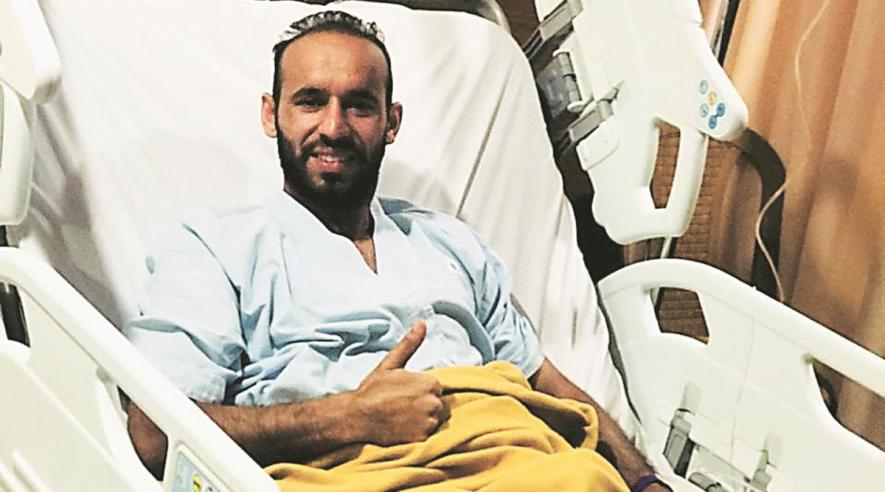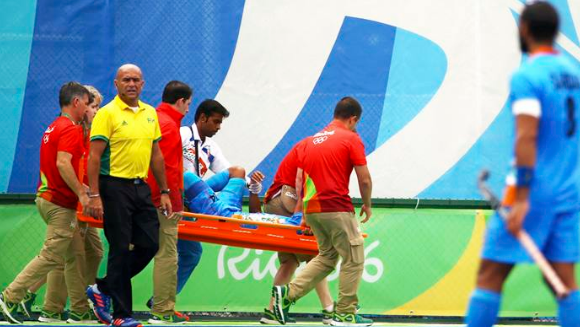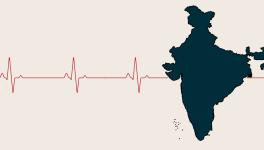Social Distancing and Quarantine: The Injury Chronicle of Two Indian Hockey Stars

Ramandeep Singh chose to not tell his parents, relatives or family about the knee injury and instead chose to complete the journey alone, first the surgery in Delhi and then to SAI Bengaluru for rehab.
“You have to not let it affect you, but it is not always easy,” Ramandeep Singh says. He is now staring at a scar on my knee, a long curving worm right below the knee cap, and shaking his head. We are exchanging injury tales. Or. We were actually talking about injuries he has had over the course of an often brilliant, but also stop-start hockey career. Midway through though, this interview has become a private therapy session.
“I’ll tell you the truth,” he says, edging forward on his chair, “Being alone helps. I learnt more about life from the injuries I’ve had than I did from the hockey I’ve played.” A few minutes earlier SV Sunil sat in that same chair. “Injuries teach you more about yourself, than anything else ever can,” he said.
Few athletes understand injuries and its lonesome recovery process the way Ramandeep Singh and SV Sunil can. Between them, they have a diverse assortment of surgeries, repairs, incisions and scars. Between them, they also have over 400 caps for the Indian hockey team.
In the last decade, the FIH Hockey World Cup was held three times. Sunil and Ramandeep, somehow, conspired to miss two each. It is hard to say which of them is unluckier. Is it Ramandeep who has missed two of them in the row (2014 and 18) right at the cusp of what was perhaps his best form on the pitch? Or is it Sunil who has done the Dougie, picking up injuries that have ruled him out the two times (2010 and ’18) the tournament has been held in India?
Ask them and you get varying reactions. Sunil just laughs and shrugs. Ramandeep’s brows furrow and he mutters the words ‘luck hi aisa hai.’
Also Read | Tokyo 2020 Olympics: Summer Games Could Get a Spring Window in 2021
Both of them remember the exact moment they realised that their luck deserted them. Sunil remembers his in slow motion. It was on the training pitch. They were doing a dribbling drill. He swerved away from a cone, felt his leg give way under him and the next moment he was down on the turf holding his knee. “You can hear the snap,” he says to me, “It’s a loud noise. Immediately pata chala ki kuch ho gaya.” This happened three weeks before the 2018 World Cup in India. He was, quite literally, on the pitch the World Cup would be played on when he fell clutching his knee.
Ramandeep’s was not quite so action packed. There was no swift realisation. He remembers feeling a tight calf when he went into halftime in the game against Pakistan at the Champions Trophy in Breda, earlier the same year. “The physio had a look, I had a look, we both agreed that it was just a cramp. And it felt perfectly alright after a massage and a gentle rubdown. We decided that if it flared up again we could tape it and I could take a decision then.”
Except it didn’t flare up at all. At least not till the final minute of the game. Ramandeep remembers making a pass in the final minute, leading to a goal, then he remembers falling down and heading to the bench. Within seconds, the final hooter blew, and everyone got up to celebrate. Everyone except Ramandeep that is.

SV Sunilâs career is littered with injuries, that too during or ahead of major tournaments, including during Indian hockey teamâs campaign at the Rio Olympics in 2016.
“Does it make any sense? You play 60 minutes. You play well. You walk off and sit on the bench on your own. Then you can’t stand up on your two feet again?”
The immediate diagnosis was terrible — a chondral fracture in the right knee. Almost immediately, the doctors warned him, prepared him for a future without hockey. “The doctors in the Netherlands said I’d broken about 14 cm of cartilage in my right knee. They would have to reconstruct, they said, and right then my heart sank,” Ramandeep says, “It didn’t matter what the procedure would be, or what the solution was, just that numerical information was scary enough for me to drop my head.” In the end, he chose to return home and get the procedure in
Delhi. Luckily, they didn’t operate for 14cm, it was more like six. Still enough for them to predict that he would be out of action for at least two years. Recovery, rehab and return.
***
What is the worst part about rehab? The repetition? The inane, mundane exercises you are forced into multiple times a day? Or just existing without full faculty, reliant on others for basic needs?
Also Read | Ode to the Nameless, Faceless Sports Empowerer Set to Lose From a No-Show IPL
It is an absurd existence for an athlete. From the daily almost monastic sensation of practice, training and preparing to hear the crowd in a stadium, they are trapped in a body that has somehow failed them, relearning the most basic movements in an empty gym. After a lifetime of solving problems on a field of play, they are suddenly at the mercy of medical professionals arguing for different solutions and plotting the best way forward. The psychological trauma of recovering from injury is sometimes more scarring than the injury itself.
Sunil, never went in for surgery and instead chose to recover via rehab. He remembers stepping back on to the pitch after being cleared to play, and sub consciously limping the first minutes of the training session. “The coach pulled me aside,” he laughs, “He asked me if I was feeling any pain. I said no. Then don’t feel for it, he said.” It was a simple message, but one few can give perfectly. The concept of a ghost limb exists. And so the ghost injury.
Ramandeep chose to not tell his parents, relatives or family about the injury and instead chose to do it alone, first in Delhi and then to SAI Bengaluru for rehab. For the first part, the team — and more specifically Akashdeep SIngh, his closest friend — pulled him together, visiting him, spending time with him and keeping him company. But as they headed off to Bhubaneswar for the World Cup camp — and for subsequent assignments — Ramandeep was isolated, on his own training for what, he didn’t really know. Loneliness is the game within the game.
The first few days of rehab are always filled with renewed hope. The athlete trusts his mental strength, finds solutions to boredom, even enjoys the time off, a chance to breathe in a forever packed sports calendar. The progress is also drastic. Every centimetre of movement is measured, hours of engagement rewarded. The irritating parts are those where you are compromised in daily life.
Ramandeep remembers waking up one morning and walking to the bathroom with his crutches to brush his teeth. Halfway through he remembers feeling dizzy and felt everything around him go hazy. “On pure instinct, I just dropped both crutches, and lunged towards the bed with one leg,” he says. “Thankfully I landed on it, reached for my phone and made a call to someone to come and help. It sounds funny now, but it was horrible!”
Gradually as he gained movement back in his legs, the head started to crumble. Every physiotherapist will tell you, the mind is the most vulnerable. An athlete at 20 percent, feeling like they are a hundred, and then crumbling mentally when they can’t get it. For Raman, this meant hours and hours spent in the gym, hurling himself at every exercise with gusto, but the rewards slowed to a crawl. The fact that Ramandeep and Sunil — for a short while — were in rehab together, made the crawl easier. But, ultimately, the struggle was private.
“I could feel some power back in the leg. I would feel my balance normalise. But then when I would try to do something more I wouldn’t manage,” Sunil says. The coaching staff and specialists at the centre were patient, prepared for most of this, having seen this very often. They pushed Sunil to review his game footage, look at himself as a third person, analyse, and learn a new skill. Ramandeep worked with the women’s team, Sjoerd Marijne inviting him to come for the training sessions and help with penalty corner routines, providing insights into injections for the flick.
Sport is about peak physical ability and peak mental performance, and in the see-saw that is rehab, something is always falling.
“There are dark days, when I would wonder if I would ever manage to play at the same level again? There were days I wondered about what I’d do if I couldn’t play anymore,” Ramandeep says. “I literally don’t know much else, only hockey. I even wondered if I was using up the federation’s good faith quicker than I had filled it.”
He was on the phone with his family by now, and several teammates from various different teams. Kanwalpreet Singh Chahal, a former player, an SP in Punjab Police, was a crutch for conversation. Chahal’s own career had ended because of a knee injury, and Ramandeep sought him out frequently to keep his fears at bay. Chahal’s advice was simple.
“Ultimately paaji, it is about yourself. You have to live with these fears but you don’t have to let these fears be your life. I had to go out and stop overthinking,” Ramandeep says. Introverted and not much of a socialiser, Ramandeep started stepping off campus, exploring Bengaluru, buying books and doing things that non-elite athletes consider normal. He gave in to his injury and learned to live with himself despite it. Being alone was revelatory.
***
Team sport, as much as they teach people about working in groups and building team spirit, end up perhaps also distancing the athlete from themselves. The thing about winning together and losing together, being a group that embodies struggle is that at an individual level you cease to rise above suffering on your own. Notice these players outside the field, in hotel lobbies or at airport lounges and you will see them wearing headphones, on their phones, walking in packs — almost as if going alone is taboo. They constantly look like people who must create an envelope of privacy around themselves with just their expressions. You forget how to be alone.
Also Read | What the Coach Fiasco Tells Us About Future of Mohun Bagan After M̶e̶r̶g̶e̶r̶ Takeover by ATK
“It’s true that I’d rarely been on my own for so long,” Ramandeep says. “It's also true what they say, that you learn more about yourself by being alone. I did. And I also resolved a lot of internal struggles in my life.”
I can testify this to be true, despite being neither an elite athlete nor a team player. If you have internal struggle, get injured. Forced to stay in, you will resolve them. Alternatively, you could wait for a global pandemic, a government shutdown and the inevitability that is solitude. But it’s not the same.
“Even now we are in Bengaluru, the whole team is in isolation,” Ramandeep says, “but we are in the comfort of each other's company. We train together and we are within earshot of each other. There is camaraderie, security.”
Having made his return to the Indian team in June and walked into a new system. A year on the sidelines of Indian hockey is a massive amount of time. Before he was injured, Harendra Singh’s Indian team almost always played a highly attacking formation — with three attackers the norm. Graham Reid is more conservative, preferring to pack the midfield than the frontline, and Ramandeep has had to play to the system.
The last time the team played, in Bhubaneswar against Australia, Ramandeep featured in the second tie, one that India won in a shootout. Sunil made his comeback in October last year, and played the game against Australia that Ramandeep didn’t play. Both are slowly making their way back to the side, having lost time at different stages.
“Ultimately it isn’t all that. What all you played, how often you played or the goals. It’s the experiences, how you lived, what’s here in your heart, what you know, what you live. No one can ever steal that from you,” Sunil says.
“Sometimes I think that if I get injured again, then that’s it,” Ramandeep says. “But then I think, it doesn’t matter. I have to live in the Now. I love hockey and no one will ever take that away from me. It's just like when you are in front of goal. Don’t celebrate before scoring. Don’t castigate before you miss.”
Get the latest reports & analysis with people's perspective on Protests, movements & deep analytical videos, discussions of the current affairs in your Telegram app. Subscribe to NewsClick's Telegram channel & get Real-Time updates on stories, as they get published on our website.
























